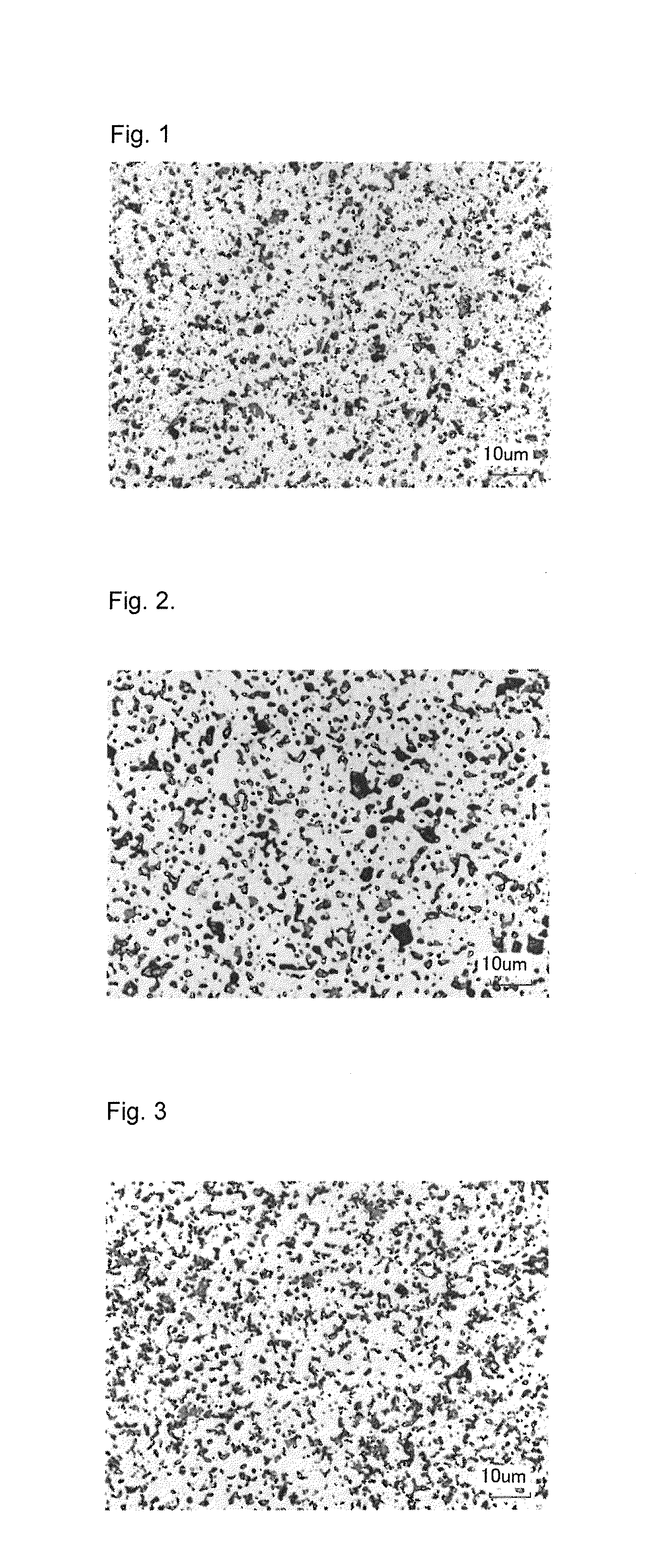Sputtering Target for Magnetic Recording Film and Process for Production Thereof
a technology of magnetic recording film and target, which is applied in the direction of diaphragm, metallic material coating process, textiles and paper, etc., can solve the problems of increasing the generation of particles during sputtering, difficult to achieve, and the burn-in time becomes longer, so as to shorten the burn-in time and reduce the defective percent of the magnetic recording film. , the effect of superior effects
- Summary
- Abstract
- Description
- Claims
- Application Information
AI Technical Summary
Benefits of technology
Problems solved by technology
Method used
Image
Examples
example 1
[0085]In Example 1, as the raw material powders, Co powder having an average grain size of 3 μm, Cr powder having an average grain size of 5 μm, and quartz powder (SiO2 powder) having an average grain size of 1 μm were prepared. These powders were weighed at the weight percentage of Co powder 81.42 wt %, Cr powder 10.72 wt %, and SiO2 powder 7.84 wt % to achieve a target composition of 80.4 Co-12 Cr-7.6 SiO2 (mol %).
[0086]Subsequently, the Co powder, Cr powder and quartz (SiO2) powder were placed in a ball mill pot with a capacity of 10 liters together with zirconia balls as the grinding medium, and rotated and mixed for 20 hours.
[0087]This mixed powder was filled in a carbon mold, and hot pressed in a vacuum atmosphere under the conditions of temperature of 1160° C., holding time of 120 minutes, and pressure of 30 MPa to obtain a sintered compact. This was further processed with a lathe to obtain a disk-shaped target having a diameter of 180 mm and thickness of 5 mm. The structure ...
example 2
[0095]In Example 2, as the raw material powders, Co powder having an average grain size of 3 μm, Cr powder having an average grain size of 5 μm, Pt powder having an average grain size of 1 μm, and quartz powder (SiO2 powder) having an average grain size of 1 μm were prepared. These powders were weighed at the weight percentage of Co powder 50.24 wt %, Cr powder 7.94 wt %, Pt powder 37.23 wt %, and SiO2 powder 4.59 wt % to achieve a target composition of 67 Co-12 Cr-15 Pt-6 SiO2 (mol %).
[0096]This mixed powder was filled in a carbon mold, and hot pressed in a vacuum atmosphere under the conditions of: temperature of 1160° C., holding time of 120 minutes, and pressure of 30 MPa to obtain a sintered compact. This was further processed with a lathe to obtain a disk-shaped target having a diameter of 180 mm and thickness of 5 mm.
[0097]The peak strength of quartz was measured by cutting out a part of the target and performing measurement based on the X-ray diffraction method. The results ...
example 3
[0104]In Example 3, as the raw material powders, Fe powder having an average grain size of 5 μm, Pt powder having an average grain size of 1 μm, and quartz powder (SiO2 powder) having an average grain size of 1 μm were prepared. These powders were weighed at the weight percentage of Fe powder 20.14 wt %, Pt powder 70.35 wt %, and SiO2 powder 9.51 wt % to achieve a target composition of 41 Fe-41 Pt-18 SiO2 (mol %).
[0105]This mixed powder was filled in a carbon mold, and hot pressed in a vacuum atmosphere under the conditions of temperature of 1200° C., holding time of 120 minutes, and pressure of 30 MPa to obtain a sintered compact. This was further processed with a lathe to obtain a disk-shaped target having a diameter of 180 mm and thickness of 5 mm.
[0106]The peak strength of quartz was measured by cutting out a part of the target and performing measurement based on the X-ray diffraction method. The results are shown in Table 1.
[0107]The peak strength appearing at 20:26.64° was 506...
PUM
| Property | Measurement | Unit |
|---|---|---|
| temperature | aaaaa | aaaaa |
| grain size | aaaaa | aaaaa |
| density | aaaaa | aaaaa |
Abstract
Description
Claims
Application Information
 Login to View More
Login to View More - R&D
- Intellectual Property
- Life Sciences
- Materials
- Tech Scout
- Unparalleled Data Quality
- Higher Quality Content
- 60% Fewer Hallucinations
Browse by: Latest US Patents, China's latest patents, Technical Efficacy Thesaurus, Application Domain, Technology Topic, Popular Technical Reports.
© 2025 PatSnap. All rights reserved.Legal|Privacy policy|Modern Slavery Act Transparency Statement|Sitemap|About US| Contact US: help@patsnap.com


